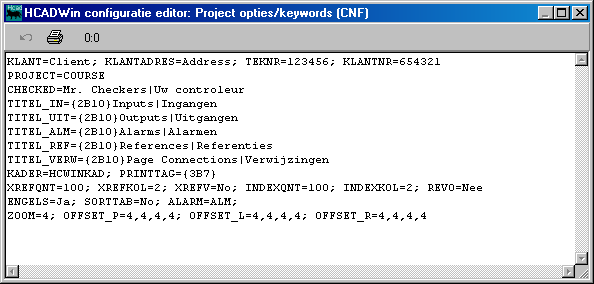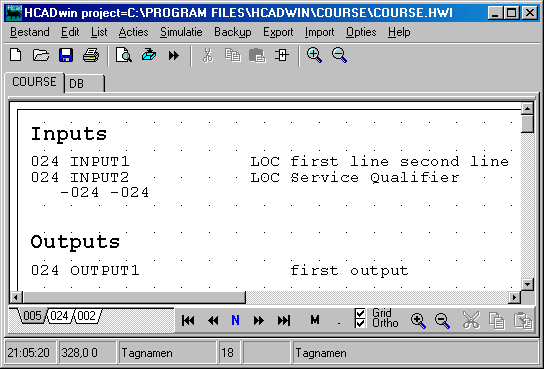CNF (project configuration)
Adjust configuration data for the cadre or project parameters.
HCADwin has an built in ASCII file for global data and parameters.
It resides in the project.HWI, but can be edited by the menu commands "Edit, Project Configuration, Project CNF".
Note that some menu commands are repositioned or renamed in newer HCADwin versions. But even in V8.1.1.3 created at 13 januari 2018, about 15 years after this Help was first written, a lot of commands are still working.

As you can see there are several keywords, like KLANT, TEKNR. Uppercase needed. In the cadre some references are made to those global keywords by using the text: "@KLANT" which is substituted by "Client".
Exercise: Try inserting a Text symbol on a page and just give it the text "@KLANT". Insert another text but now give it the text "%TITEL".
Note that the keyword "CHECKED" has a string with a vertical bar "|" in it. When ENGELS=Yes (or Ja) the first part will be used for substitution, otherwise the second part. This mechanism makes HCADwin bilingual.
Where a string starts with {2B10} HCADwin will use Font 2, Bold, 10 points high for the text.
HCADwin supports 6 fonts, which can be altered with "Edit, Fonts". The 0 font is the default font. The letter "B" could be "N" Normal, "I" Italic, or "C" for both Italic and bold. Note that when exporting to ACAD these fonts will not be exported.
The TITEL_xxx keywords are used for the cross-reference categories. As you can see below. The number of cross-reference lines on a page is set by XREFQNT=100, which fits on a normal portrait page. Adjust this when using landscape. The number of columns is set by XREFKOL=2, giving two columns on each page. When using 3 or more, the descriptions disappear.
When creating a cross-reference the file "ProjectName.HXF" is created. This file is plain ASCII and can be used in other software.
The REV0=No (or Nee) stands for the automatic revision being a "0" when Yes, or "A" when no for newly created pages.
The KADER=HCWINKAD instruction tells HCADwin to use the HCWINKAD.HKP definition for the border frame for portrait pages. Make your own cadres and give it another name en change the KADER= instruction accordingly. The HCWINKAD.HKP uses the bitmaps HCADLOGO.BMP and HCATLOGO.BMP. Examine "Edit, Cadres, Portrait cadre" to see how easy you can change it. NB. Don't use too many colors, 256 will be sufficient.
When tags have an ALARM attribute in the DBF("A" column) and the CNF contains an instruction like: "ALMTEST=0,1,2,3;SETTEST=P,F,T" it will create an extra cross-reference category when outputs are using one of the mentionend characters in the Alarm List (same for the Setting List). Some suppliers want to know the alarm list, so HCADwin has this feature. Use the EXCEL export to retrieve these lists in an own format.

The cross-reference itself looks like the above picture. Note that INPUT1 is used on page 24 only. INPUT2 is used on page 24 for the first time, but also in the same page (both as an input) again. The page number where the tag resides stands for the tag. When a tag is more often used, the complete cross-reference is listed just under the tag. The minus sign indicates the tag as used in an input symbol, a plus sign indicates an output symbol and no sign indicates another reference. Like a PID controller for example.
When the cross-reference doesn't fit on one page, the first unused next page number is than allocated.
So don't use page 999 for it, you will probably loose information!
When grouping projects, a group list will appear before the Inputs category. All listed tags which are used in other projects will display extra lines, indicating a page number and the name (including path) of the other project. (The display of those tags will also have a character added on the logic pages to indicate this). The making of the cross-reference is done when the first cross-reference page has to be redrawn (or printed). On that very moment the descriptions of tags which are outputs in the other projects are copied into this project database, thus keeping the descriptions always
identical.
As you understand by these remarks, HCADwin creates the connection between two or more projects on the identical tag basis. In case of multiple writers the last one wins. (Or more specific: after writing by one project its value can be read by others instantaneously, until changed by another. HCsimul will execute the projects after each other in the same order as defined in the GRP definition)
What we have learned:
- Global parameters, such like the clients name and address, project numbers, drawing numbers, can be found in the Project.CNF which is included in the Project.HWI, but can be edited by HCADwin directly.
- Many global parameters are used to define the border frame (cadre).
- HCADwin will evaluate all texts before displaying them. This can be used for defining other fonts or sizes ({font definition} must be the very first part of a text then. Strings starting with an "@keyword" can be substituted by the corresponding string from the CNF. Strings starting with "%" can be substituted by page-dependant strings. (TITEL, ENGINEER, REV, BLZ, NBLZ and some more will work here. Read the HelpWeb pages for more details)
- The cross-reference is fully automated. HCADwin will generate it when a cross-reference page exists.












